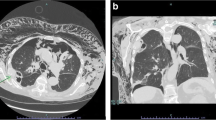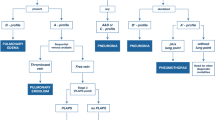Summary.
Thoracic empyema may be based on four different etiologic mechanisms of infection: (1) parapneumonic, (2) posttraumatic, (3) postspecific, (4) postsurgical. According to morphologic processes, three different time-dependent stages may be present: (1) exudative phase, (2) fibrino-purulent phase, (3) organization and pleural peel formation. Diagnosis and pleural puncture are based on the findings of thoracic CT and transthoracic ultrasonography. Thoracocentesis, however – even if performed repeatedly – is not an appropriate treatment of empyema. Chest tube drainage and irrigation of the pleural cavity is appropriate only in stage I and early stage II disease to re-establish total lung inflation and healing without pleural peel formation. Selected stage II cases may benefit from video-assisted débridement, but a 30 % conversion rate to open thoracotomy has to be assumed. Residual organized cavities, loculated peels etc. require open thoracotomy and empyemectomy, decortication or combined maneuvers. For treatment quality and outcome it is not only decisive to remove the source of infection but also to reexpand the entire lung without remaining restrictive peels and without relevant leaks.
Zusammenfassung.
Das Pleuraempyem kennt vier verschiedene Infektursachen: 1. metapneumonisch, 2. posttraumatisch, 3. postspezifisch, 4. iatrogen. Der klassische Ablauf – heute durch einsetzende Therapiemaßnahmen kaum noch zu beobachten – unterscheidet die (a) exsudative Phase, (b) fibrinös/purulente Phase, (c) Phase der Organisation und Verschwielung. Diagnostisch bedeutsam ist neben der Thoraxübersicht insbesondere die CT- und transthorakale Ultraschalluntersuchung, die als Markierung für die initiale Punktion (Erregernachweis) dient. Mehrfache Punktionen stellen keine adäquate Behandlung des Empyems dar, nur im Stadium I und früh im Stadium II ist durch Drainagebehandlung mit adäquater Spülung eine befriedigende Ausheilung ohne Schwielenbildung zu erreichen. Ausgewählte Fälle im Stadium II scheinen für instrumentelles Débridement unter videoskopischer Kontrolle gut geeignet. Empyemrestzustände (Schwielen- und Höhlenbildung, Absceß, Parenchymfistel etc.) bedürfen des offenen Débridements und evtl. der Decortication durch den Thoraxchirurgen. Für die Qualität der Behandlung entscheidend ist nicht nur die Beseitigung der Infektionsursache, sondern auch der funktionelle Endzustand nach Ausheilung: Ultimatives Therapieziel ist die vollständige Wiederentfaltung der gesamten Lunge ohne zurückbleibende restriktive Schwielenbildung.
Similar content being viewed by others
Author information
Authors and Affiliations
Rights and permissions
About this article
Cite this article
Sunder-Plassmann, L. Das Pleuraempyem. Chirurg 69, 821–827 (1998). https://doi.org/10.1007/s001040050496
Issue Date:
DOI: https://doi.org/10.1007/s001040050496




